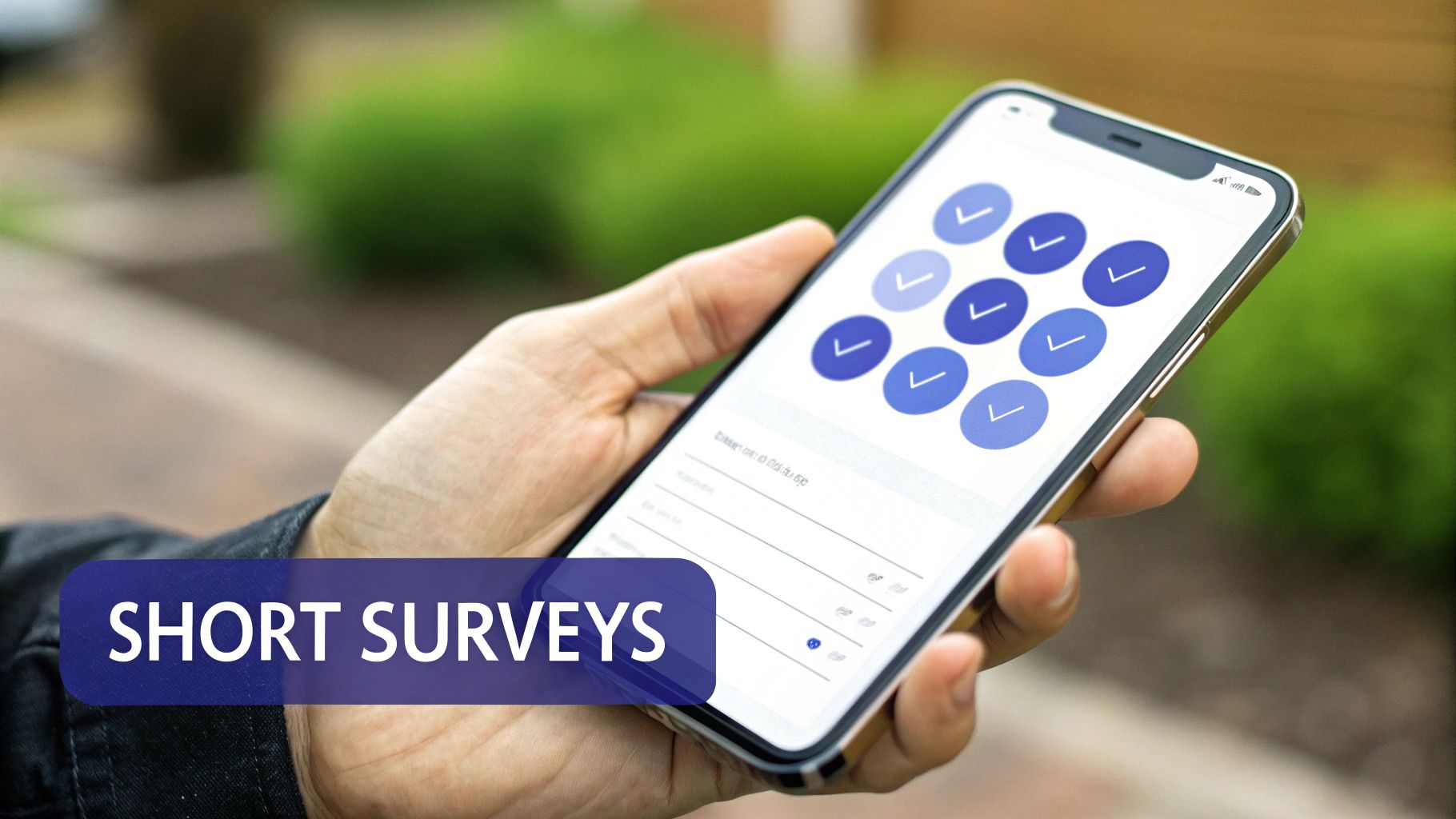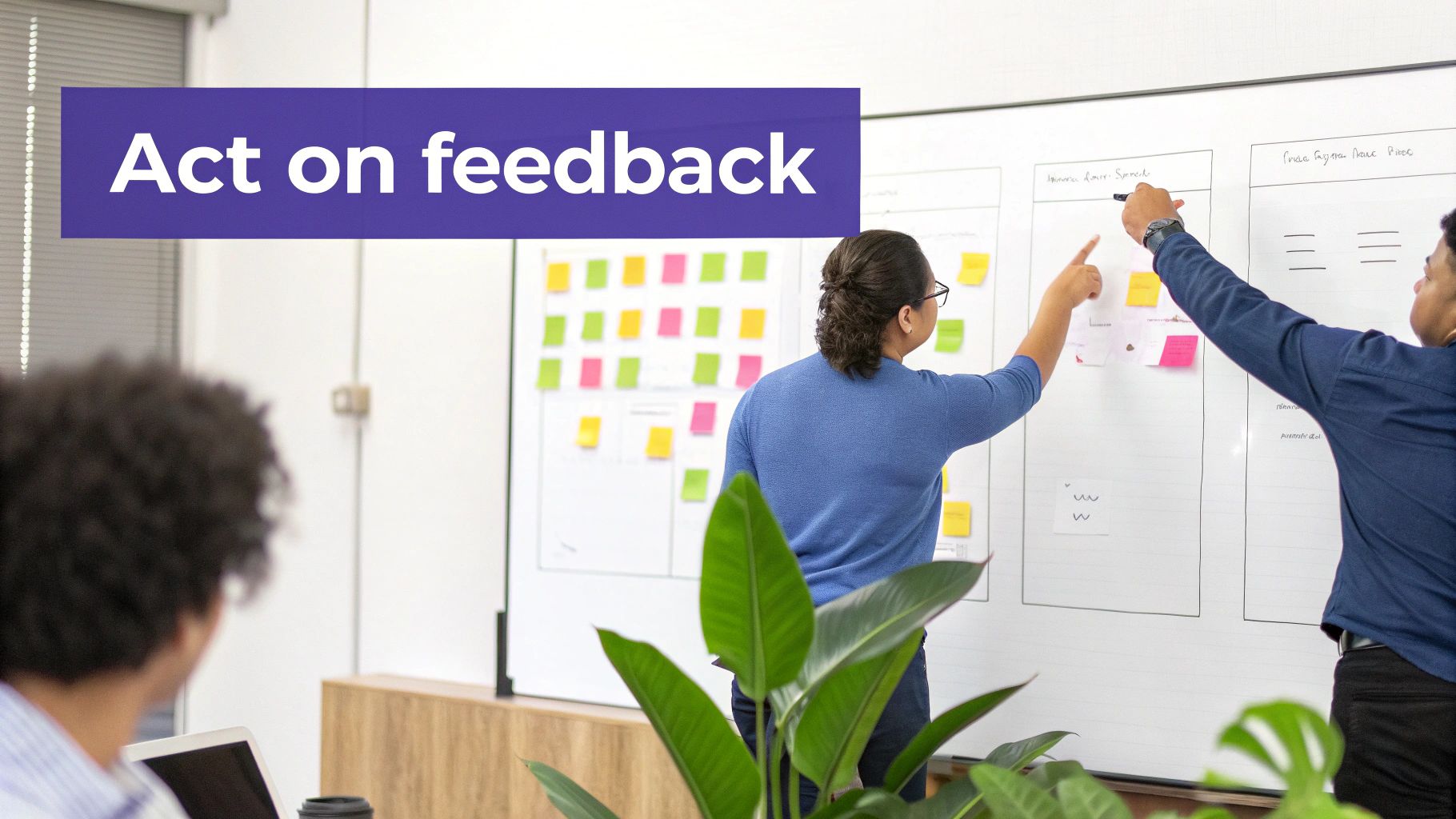How to Collect Feedback from Clients Effectively
Learn how to collect feedback from clients with practical methods. Discover the right channels and tools to gain valuable insights that drive business growth.

Think of client feedback as a goldmine, not a suggestion box. It's about listening to what your clients are experiencing with your products, services, and brand. You can use anything from surveys and in-app widgets to good old-fashioned conversations to gather these insights, which are the fuel for growth and loyalty.
This process is about turning client opinions into your most valuable strategic asset.
Why Client Feedback Is a Growth Engine
Before getting into the how, let's talk about the why. Why is this so important? Client feedback is a direct line into what’s working and what’s not inside your business. It is about using real-world insights to stay ahead of the curve.
When you actively listen to your clients, you improve customer satisfaction and boost loyalty. It’s a clear signal that you value their perspective, and that goes a long way. In fact, one study found that companies acing the customer experience drive revenues 4-8% higher than their competitors. That’s not a coincidence. Listening is directly tied to your bottom line.
From Simple Fixes to Strategic Innovation
A lot of businesses see feedback as a way to handle complaints. That is part of it. The real magic happens when you start using those insights to innovate. Your clients are in the trenches with your products every day, giving them a viewpoint you can’t get from inside the office. They are the ones discovering new ways to use your tools or getting tripped up by tiny frustrations you might have overlooked.
For instance, a software company might learn that a feature they built for one thing is being used for something completely different. That kind of information is priceless. It can lead directly to:
- New Product Features: You can lean into how clients actually use the product and build out functionality that supports their real-world workflows.
- Improved User Experience: Sometimes it’s the little things. Feedback can highlight small points of friction that, once removed, make the whole experience smoother and more intuitive.
- Better Marketing: When you know what benefits your clients truly value, you can stop guessing and start adjusting your messaging to reflect that.
Treat feedback as a stream of brilliant ideas, not just a list of problems. When you do that, your clients practically become an extension of your product development team, handing you a clear roadmap for what to build next.
Building Stronger Client Relationships
Actively seeking out and acting on feedback does more than just make your offerings better. It builds trust. It strengthens the relationship.
When a client sees a suggestion they made actually get implemented, they feel heard and respected. It's a powerful moment. That one simple act of closing the loop can turn a happy customer into a vocal advocate for your brand. This is about building a genuine partnership.
Choosing the Right Channels to Listen
Deciding how to collect feedback from clients starts with a simple question: where are they already spending their time? The best approach is always to meet them where they are, instead of forcing them into a channel that feels unnatural or inconvenient.
There’s no single “best” method here. The right mix depends entirely on your business and, more importantly, your clients.
For instance, a B2B service provider might get rich, detailed insights from a scheduled 15-minute phone call. On the other hand, an e-commerce store could get a huge volume of immediate data from a quick, one-question survey that pops up right after a purchase.

This visual really drives the point home. Actively seeking out and using feedback is what fuels innovation. Ignoring it? That’s a fast track to falling behind.
Common Channels for Client Feedback
So, where do you start? Most businesses begin with a few core channels and then expand from there. It's smart to use a mix of both proactive methods (where you actively ask) and passive methods (where you just listen).
Here are a few popular options to get you thinking:
- Email Surveys: Still a workhorse for feedback, email lets you send more detailed surveys like Net Promoter Score (NPS) or Customer Satisfaction (CSAT) questionnaires. They’re great for relationship check-ins or post-project reviews.
- In-App or Website Widgets: Tools like Surva.ai allow you to embed non-intrusive feedback forms directly on your site or inside your product. This is perfect for capturing contextual feedback right in the moment a client is using a feature.
- Social Media Listening: Your clients might be talking about you on platforms like X (formerly Twitter), LinkedIn, or Facebook without ever tagging you. Using tools to monitor brand mentions helps you tap into unfiltered, spontaneous opinions.
- Direct Phone Calls or Video Chats: For high-value B2B clients, nothing beats a direct conversation. It allows you to ask follow-up questions and really get the nuances behind their answers in a way a form just can't.
Selecting Your Mix of Channels
Picking the right channels requires a bit of strategy. A recent global study found that while online surveys are still popular, a growing number of consumers prefer real-time digital channels like social media and live chat for communication.
What’s interesting is that the research also showed clients use different channels depending on whether their experience was good or bad. This makes a multi-channel strategy even more important. You can dig into the specifics in the full research about global feedback channel preferences.
To help you decide, let's break down the common channels and see where they shine and where they might fall short.
Comparing Client Feedback Collection Channels
Choosing your feedback channels is a balancing act. Each one offers a different kind of insight, and what works for one business might not work for another. This table compares some of the most popular methods to help you figure out the best fit for your goals.
Ultimately, the goal is to get a well-rounded view. No single channel will give you the complete story, so mixing and matching is key to getting the full client experience.
Your goal should be to create a complete picture of the client experience. Relying on just one channel gives you a single, potentially biased, snapshot. A multi-channel approach provides a much more balanced and accurate view.
The best way to figure out how to collect feedback from clients is simply to start. Test a few different methods. Pay close attention to your response rates and, more importantly, the quality of the insights you get back. Over time, you’ll discover which combination of channels gives you the clearest, most actionable picture of what your clients truly need.
Designing Surveys Clients Actually Complete
A long, confusing survey is the fastest way to get your request ignored. If you want clients to give you feedback, how you design your survey is just as important as the channel you use to send it. Your goal is to make the experience so easy and intuitive that clients don't think twice about clicking through.
The single biggest mistake I see is asking for too much of their time. One study found that survey abandonment rates shoot way up after the 10-minute mark. Keeping it short and sweet respects your client's time and dramatically increases your chances of getting a full set of answers.

Another absolute must-have is mobile optimization. It's a necessity. Over 60% of surveys are now opened on a phone. If your survey forces someone to pinch and zoom just to read the questions, you’ve already lost them. Make sure your design is responsive and looks fantastic on a small screen.
Writing Questions That Get Clear Answers
The way you word your questions has a massive impact on the quality of feedback you get back. It’s very important to write clear, neutral questions that don’t subtly nudge the client toward the answer you want to hear.
Avoid loaded language at all costs. Instead of asking something like, "How much did you enjoy our amazing new feature?" you should rephrase it. A much more neutral (and useful) approach would be, "How would you rate your experience with our new feature on a scale of 1 to 5?" This simple switch removes bias and gives you much more honest feedback.
To get the full story, it's also a great idea to mix up your question types. Combining a few different formats gives you both the hard data and the qualitative story behind the numbers.
- Net Promoter Score (NPS): The classic "How likely are you to recommend us?" is perfect for measuring overall client loyalty. It boils everything down to a single, easy-to-track metric.
- Customer Satisfaction (CSAT): Questions like, "How satisfied were you with your recent support interaction?" are brilliant for getting immediate feedback on a specific touchpoint. They help you pinpoint exactly what’s working and what isn’t.
- Open-Ended Questions: Never underestimate the power of a simple, "Is there anything else you'd like to share?" This is often where the gold is. It's where you'll find the most valuable, unexpected insights that multiple-choice questions just can't capture.
The best surveys feel less like an interrogation and more like a conversation. Mix quantitative questions for data with open-ended ones for context. This balanced approach gives you the full picture.
Timing Your Survey for Maximum Impact
When you ask for feedback is almost as important as what you ask. Sending a short, targeted survey right after a purchase or a support ticket resolution often gets much better response rates than a long, generic quarterly one. The experience is still fresh in the client's mind.
For example, a one-question CSAT survey sent the moment a support chat closes can give you instant data on agent performance. On the other hand, an annual NPS survey is better for gauging the overall health of your client relationships over the long haul.
Think about your client's journey and identify those key moments where feedback would be most valuable. This strategic timing makes your request feel relevant and helpful, not like just another interruption. If you want to go even deeper on crafting effective questions and layouts, check out our complete guide on survey design best practices. It’s packed with tips for refining your approach and getting more completions.
Using Technology for Smarter Feedback Collection
Let's be honest: manually digging through hundreds of survey responses or social media comments just doesn't cut it anymore. If you want to really know your clients, you need to move beyond simply collecting data and start finding the meaningful patterns hidden within it.
Luckily, technology gives us some incredibly powerful ways to automate and sharpen the entire feedback process.
Modern feedback tools are much more than just survey senders. Think of them as a central hub, pulling in feedback from all over the place—reviews, support tickets, in-app messages—and creating a single, unified picture of the client experience.
Instead of your client feedback living in separate silos for marketing, support, and product teams, these platforms bring it all together. This shared view helps your entire company stay on the same page about what clients actually want and need.
Moving from Reactive to Predictive Insights
The real game-changer with technology is the ability to make sense of unstructured feedback at scale. Think about all the gold locked away in open-ended survey questions, product reviews, or chat logs. It’s full of rich context, but it’s nearly impossible to analyze by hand.
This is where AI-powered platforms shine. They can instantly scan thousands of text responses and perform sentiment analysis, figuring out if the feedback is positive, negative, or neutral. But they go deeper than that, pinpointing recurring themes and keywords.
For example, an AI tool might flag that 15% of recent negative comments mention the phrase "confusing checkout process." That kind of specific, data-backed insight lets you fix problems proactively, often before they blow up into bigger issues. The goal is to get ahead of client needs instead of just reacting to complaints. You can dig deeper into how AI surveys uncover these insights to improve your methods.
This shift is fundamentally changing how businesses compete. In fact, Gartner research shows that 80% of executive leaders now see customer experience as the primary competitive battleground. The trend is clear: we're moving from simply collecting feedback to using predictive intelligence to stay ahead. You can find more insights on this in 2025 customer feedback trends from Clootrack.
Automating the Feedback Loop
Technology is also a massive help when it comes to closing the loop with clients efficiently. Smart feedback systems can trigger automated actions based on the kind of responses you get.
Here’s what that looks like in the real world:
- Deflecting Churn: If a client gives a low NPS score, the system can automatically shoot them a personalized email from a customer success manager to schedule a call. Platforms like Surva.ai can even present targeted offers in real time, like a discount or a temporary subscription pause, to keep at-risk customers from leaving.
- Gathering Testimonials: When a client leaves a glowing review or a high CSAT score, the system can follow up with a request for a public testimonial or case study. This is a brilliant way to automate the process of collecting social proof from your happiest customers.
- Routing Internal Alerts: Negative feedback about a specific feature can automatically create a ticket in your development team’s project management tool. This makes sure the right people see it immediately, without any manual hand-off.
By automating these follow-up actions, you make sure no piece of feedback ever falls through the cracks. It turns client input into a continuous, automated cycle of listening, acting, and improving. This is how you make client feedback a core part of your daily operations.
Turning Feedback into Meaningful Action
Gathering client opinions is just the start. Let's be honest, the real work begins when you turn all that raw data into actual improvements. Without a system to analyze and act on what you learn, the best feedback in the world just sits in a spreadsheet, gathering digital dust.
The first thing you have to do is organize the feedback. You can’t fix everything at once, so you need to categorize what you’re hearing to spot the most important trends. Are multiple clients mentioning the same bug? Is there a common request for a new feature? Grouping similar comments together makes these patterns jump right out.

This process moves you from simply collecting stories to setting data-backed priorities. You can start to weigh which issues are impacting the most clients or which suggestions align best with your business goals. For a deeper look, our guide on https://www.surva.ai/blog/analyzing-survey-data offers some seriously practical methods for making sense of your results.
Create an Internal Feedback Loop
Once you’ve identified the key takeaways, it’s time to get that information to the right people. An internal feedback loop is just a simple process for making sure insights are shared with the teams that can actually make changes.
This doesn't need to be complicated at all. It could be a dedicated Slack channel where customer support shares daily feedback with the product team. Or it might be a quick weekly huddle where marketing reviews client comments to tweak its messaging.
The whole point is to make client feedback a regular part of everyone's workflow. It puts the voice of the client as a constant influence on your decisions, from minor bug fixes all the way up to your long-term product roadmap.
Always Close the Loop with Your Clients
This is probably the most overlooked and most powerful part of the whole process. Closing the loop just means going back to the clients who gave you feedback and telling them what you did with it.
It can be as simple as an email that says, "Hey, remember that feature you suggested? We built it!" This one move does two incredible things:
- It shows you’re listening. Clients feel heard and valued, which builds massive loyalty.
- It encourages more feedback. When people know their opinions lead to real change, they’re far more likely to share their thoughts again.
Customers also expect faster responses than ever before. Businesses using instant feedback tools are gaining a clear advantage here. For instance, a low survey score can trigger an automatic alert for your service team, letting them engage with an unhappy customer almost immediately.
For businesses looking to get immediate insights from what their clients are saying, Mastering Real-Time Data Analytics can turn that raw feedback into intelligence you can act on right away.
By consistently analyzing feedback, acting on it internally, and closing the loop with clients, you transform feedback from a simple data point into a powerful engine for building better products and stronger relationships. It’s a continuous cycle of listening, improving, and communicating.
Common Questions About Client Feedback
Even with a solid plan, a few practical questions always pop up when you start asking clients for their thoughts. Nailing these details can be the difference between a feedback process that hums along smoothly and one that just doesn't. Let's look at some of the most common ones I hear.
How Often Should I Ask Clients for Feedback?
There’s no magic number here, as the right frequency hinges on your business model. The best rule of thumb is to sync your requests with the natural lifecycle of your customer relationship.
For a one-time thing, like a sale on your e-commerce site, you'll want to ask for feedback almost right away. The experience is still fresh. But for ongoing services, like a SaaS subscription or a long-term project, quarterly check-ins or annual relationship surveys usually hit the sweet spot. The key is consistency without being annoying.
A smart way to handle this is to mix it up. Use quick, automated surveys for specific moments (like right after a support ticket closes). Save the bigger, relationship-deepening surveys for those less frequent check-ins. This gives you a steady stream of insights without wearing out your welcome.
What Is the Best Way to Encourage Feedback?
Getting people to respond boils down to two simple things: make it dead simple for them, and show them you’re listening. Nobody has time for a long, clunky form. Keep your surveys short, mobile-friendly, and packed with clear, straightforward questions.
When you ask, tell them why you're asking. A quick line like, "Your feedback helps us make this better for you," can work wonders.
A small thank-you, like a discount code or an entry into a giveaway, can definitely boost response rates. But honestly, the most powerful motivator is proving that their feedback leads to real change.
How Should I Handle Negative Feedback?
Okay, first things first: take a breath. Don't get defensive. Think of negative feedback as a gift because it's a free consultation telling you exactly what's broken. This person is giving you a chance to fix something you might not have even known about.
Your first move should always be to respond, and fast. Thank the client for sharing their experience. Acknowledge their frustration and really listen to what they're saying to get to the root of the problem. If you need more info, don't be afraid to ask a few clarifying questions.
Once you’ve got the full picture, own any mistakes your company made. Then, tell them the specific steps you're going to take to make it right for them and to make sure it doesn't happen again. A quick follow-up a week or two later to check in is a total power move. It shows you genuinely care and can turn a really sour experience into a surprisingly positive one.
Ready to turn client feedback into your biggest growth driver? Surva.ai gives you the tools to collect, analyze, and act on client insights automatically. Reduce churn, gather powerful testimonials, and build better products by listening to what your users are telling you. See how it works at https://www.surva.ai.


